Digital Learning: Transforming Schools and Education in Australia
VerifiedAdded on 2022/11/07
|17
|4612
|286
Report
AI Summary
This report explores the evolving landscape of digital learning and its profound impact on schools and education, particularly within the context of Australia. It begins by highlighting the increasing importance of technological advancements and the shift towards digitized learning environments. The report emphasizes the benefits of digital learning, such as freedom of space, flexible time, and access to digitalized content, including the availability of various digital learning tools like Edmodo, Socrative, Projeqt, Storybird, TED-Ed, and Animoto. It also addresses the opportunities and challenges associated with the adoption of digital learning, providing recommendations to overcome potential obstacles. Overall, the report underscores the transformative potential of digital learning in enhancing the educational experience and preparing students for the future, while also acknowledging the need for educators to select appropriate digital tools and address associated challenges. This report is contributed by a student to be published on the website Desklib. Desklib is a platform which provides all the necessary AI based study tools for students.
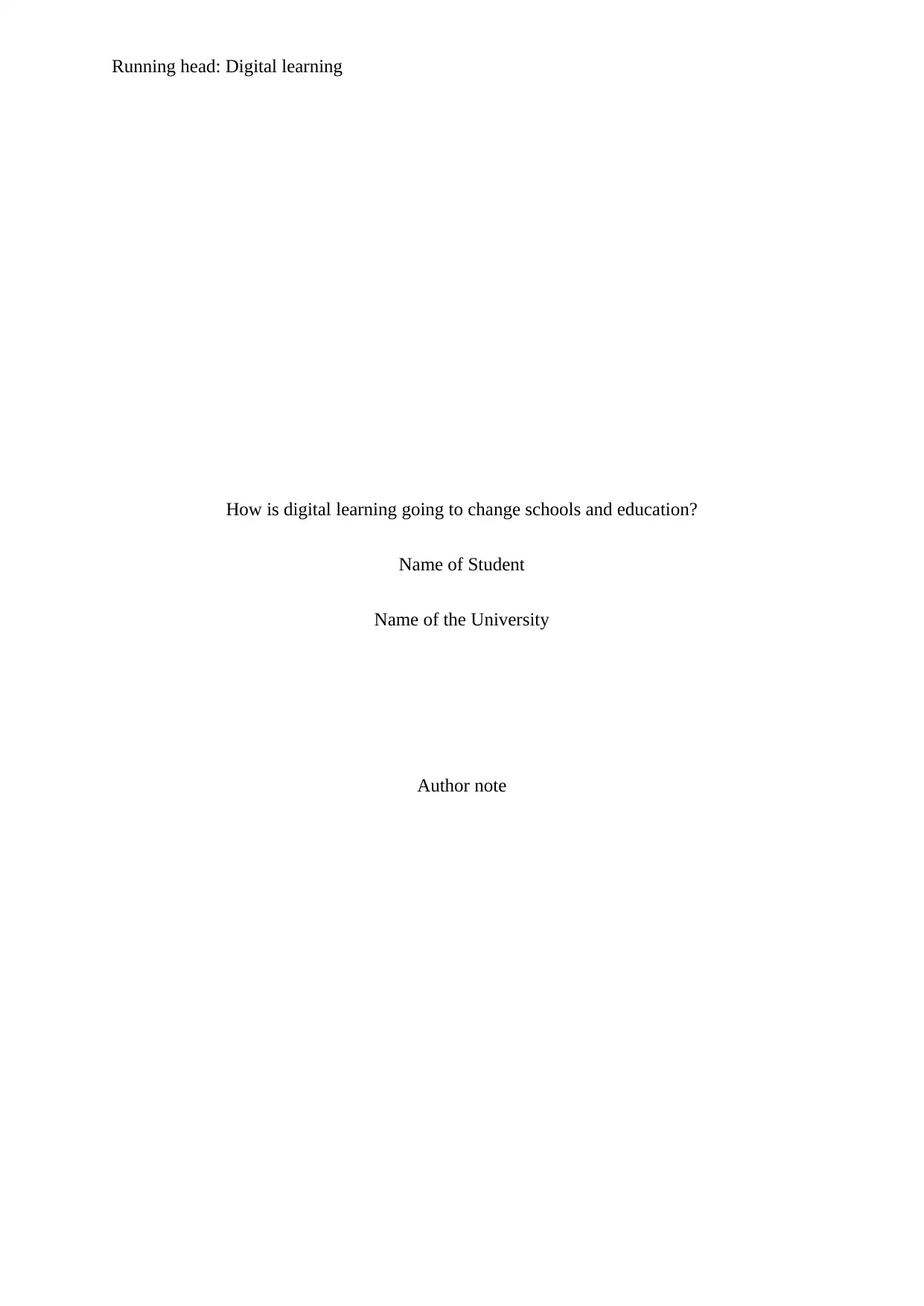
Running head: Digital learning
How is digital learning going to change schools and education?
Name of Student
Name of the University
Author note
How is digital learning going to change schools and education?
Name of Student
Name of the University
Author note
Paraphrase This Document
Need a fresh take? Get an instant paraphrase of this document with our AI Paraphraser
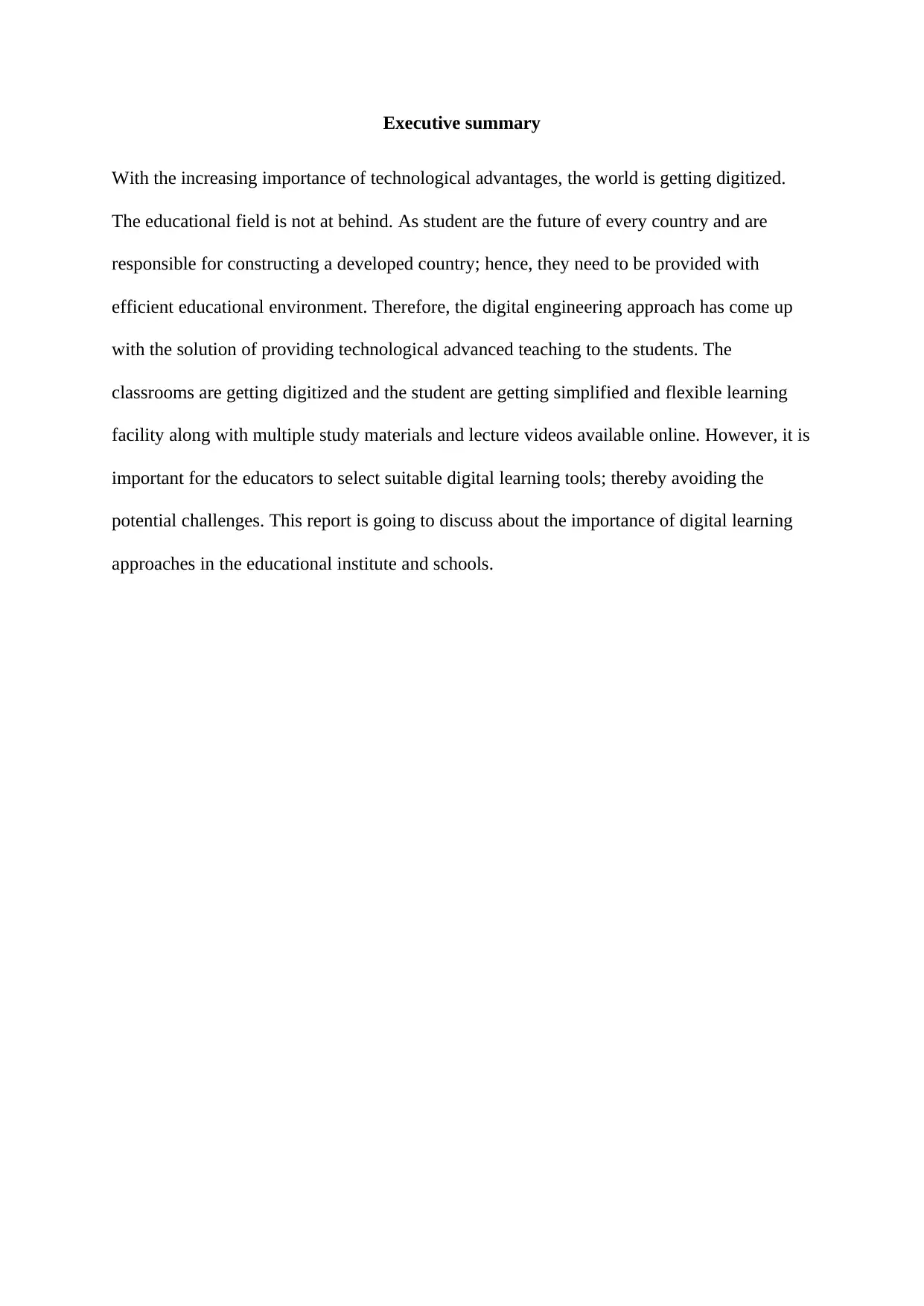
Executive summary
With the increasing importance of technological advantages, the world is getting digitized.
The educational field is not at behind. As student are the future of every country and are
responsible for constructing a developed country; hence, they need to be provided with
efficient educational environment. Therefore, the digital engineering approach has come up
with the solution of providing technological advanced teaching to the students. The
classrooms are getting digitized and the student are getting simplified and flexible learning
facility along with multiple study materials and lecture videos available online. However, it is
important for the educators to select suitable digital learning tools; thereby avoiding the
potential challenges. This report is going to discuss about the importance of digital learning
approaches in the educational institute and schools.
With the increasing importance of technological advantages, the world is getting digitized.
The educational field is not at behind. As student are the future of every country and are
responsible for constructing a developed country; hence, they need to be provided with
efficient educational environment. Therefore, the digital engineering approach has come up
with the solution of providing technological advanced teaching to the students. The
classrooms are getting digitized and the student are getting simplified and flexible learning
facility along with multiple study materials and lecture videos available online. However, it is
important for the educators to select suitable digital learning tools; thereby avoiding the
potential challenges. This report is going to discuss about the importance of digital learning
approaches in the educational institute and schools.
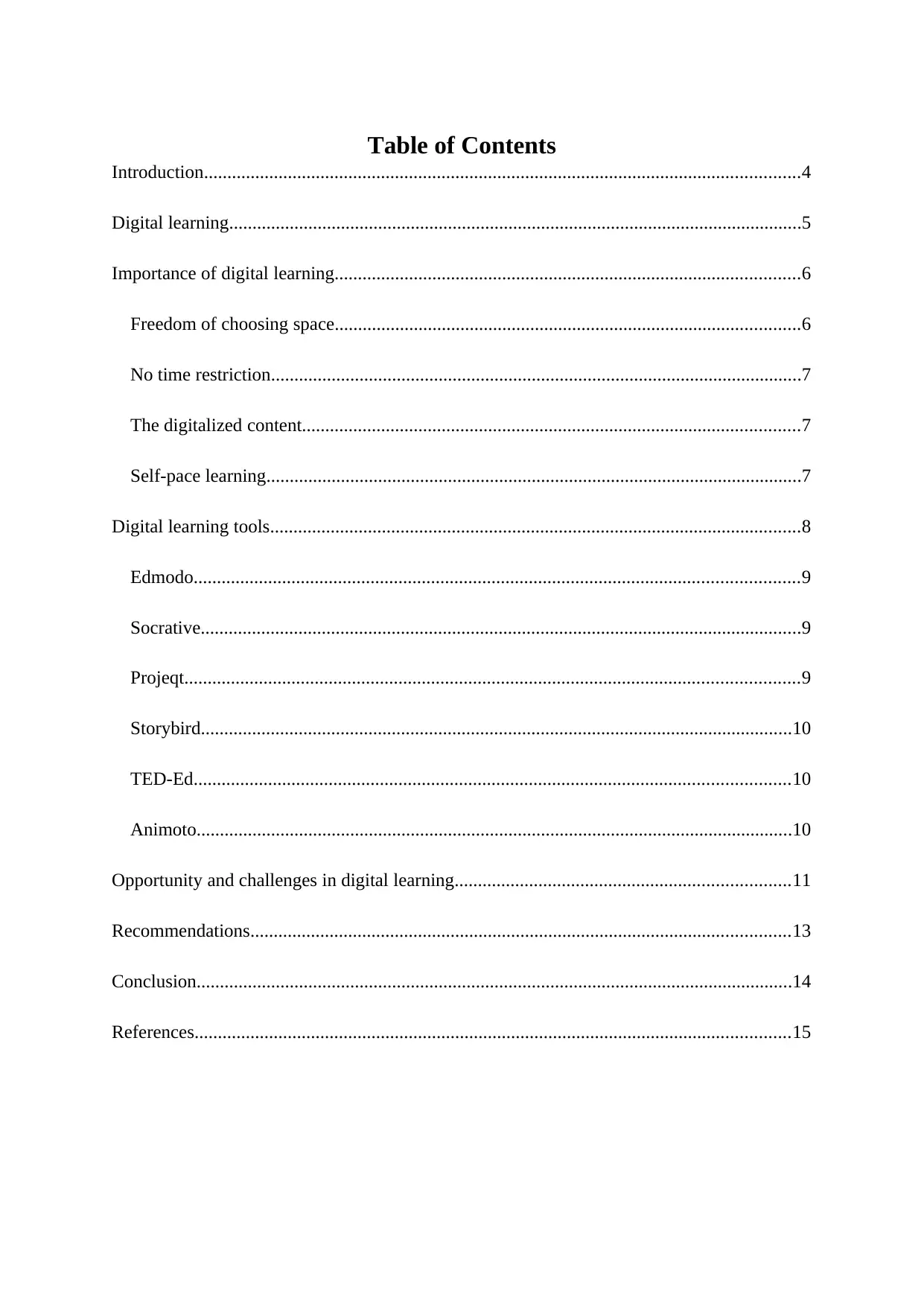
Table of Contents
Introduction................................................................................................................................4
Digital learning...........................................................................................................................5
Importance of digital learning....................................................................................................6
Freedom of choosing space....................................................................................................6
No time restriction..................................................................................................................7
The digitalized content...........................................................................................................7
Self-pace learning...................................................................................................................7
Digital learning tools..................................................................................................................8
Edmodo..................................................................................................................................9
Socrative.................................................................................................................................9
Projeqt....................................................................................................................................9
Storybird...............................................................................................................................10
TED-Ed................................................................................................................................10
Animoto................................................................................................................................10
Opportunity and challenges in digital learning........................................................................11
Recommendations....................................................................................................................13
Conclusion................................................................................................................................14
References................................................................................................................................15
Introduction................................................................................................................................4
Digital learning...........................................................................................................................5
Importance of digital learning....................................................................................................6
Freedom of choosing space....................................................................................................6
No time restriction..................................................................................................................7
The digitalized content...........................................................................................................7
Self-pace learning...................................................................................................................7
Digital learning tools..................................................................................................................8
Edmodo..................................................................................................................................9
Socrative.................................................................................................................................9
Projeqt....................................................................................................................................9
Storybird...............................................................................................................................10
TED-Ed................................................................................................................................10
Animoto................................................................................................................................10
Opportunity and challenges in digital learning........................................................................11
Recommendations....................................................................................................................13
Conclusion................................................................................................................................14
References................................................................................................................................15
⊘ This is a preview!⊘
Do you want full access?
Subscribe today to unlock all pages.

Trusted by 1+ million students worldwide
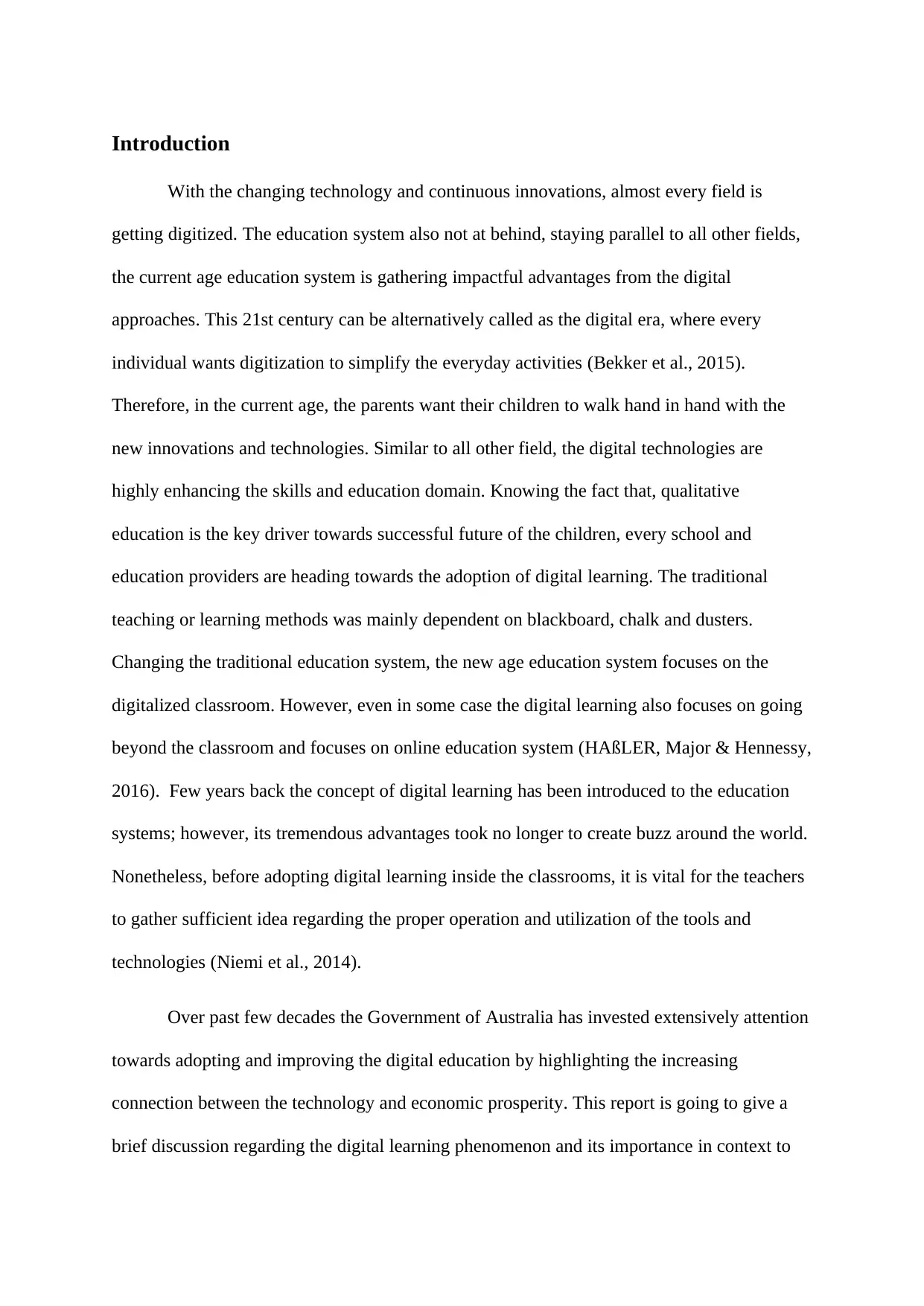
Introduction
With the changing technology and continuous innovations, almost every field is
getting digitized. The education system also not at behind, staying parallel to all other fields,
the current age education system is gathering impactful advantages from the digital
approaches. This 21st century can be alternatively called as the digital era, where every
individual wants digitization to simplify the everyday activities (Bekker et al., 2015).
Therefore, in the current age, the parents want their children to walk hand in hand with the
new innovations and technologies. Similar to all other field, the digital technologies are
highly enhancing the skills and education domain. Knowing the fact that, qualitative
education is the key driver towards successful future of the children, every school and
education providers are heading towards the adoption of digital learning. The traditional
teaching or learning methods was mainly dependent on blackboard, chalk and dusters.
Changing the traditional education system, the new age education system focuses on the
digitalized classroom. However, even in some case the digital learning also focuses on going
beyond the classroom and focuses on online education system (HAßLER, Major & Hennessy,
2016). Few years back the concept of digital learning has been introduced to the education
systems; however, its tremendous advantages took no longer to create buzz around the world.
Nonetheless, before adopting digital learning inside the classrooms, it is vital for the teachers
to gather sufficient idea regarding the proper operation and utilization of the tools and
technologies (Niemi et al., 2014).
Over past few decades the Government of Australia has invested extensively attention
towards adopting and improving the digital education by highlighting the increasing
connection between the technology and economic prosperity. This report is going to give a
brief discussion regarding the digital learning phenomenon and its importance in context to
With the changing technology and continuous innovations, almost every field is
getting digitized. The education system also not at behind, staying parallel to all other fields,
the current age education system is gathering impactful advantages from the digital
approaches. This 21st century can be alternatively called as the digital era, where every
individual wants digitization to simplify the everyday activities (Bekker et al., 2015).
Therefore, in the current age, the parents want their children to walk hand in hand with the
new innovations and technologies. Similar to all other field, the digital technologies are
highly enhancing the skills and education domain. Knowing the fact that, qualitative
education is the key driver towards successful future of the children, every school and
education providers are heading towards the adoption of digital learning. The traditional
teaching or learning methods was mainly dependent on blackboard, chalk and dusters.
Changing the traditional education system, the new age education system focuses on the
digitalized classroom. However, even in some case the digital learning also focuses on going
beyond the classroom and focuses on online education system (HAßLER, Major & Hennessy,
2016). Few years back the concept of digital learning has been introduced to the education
systems; however, its tremendous advantages took no longer to create buzz around the world.
Nonetheless, before adopting digital learning inside the classrooms, it is vital for the teachers
to gather sufficient idea regarding the proper operation and utilization of the tools and
technologies (Niemi et al., 2014).
Over past few decades the Government of Australia has invested extensively attention
towards adopting and improving the digital education by highlighting the increasing
connection between the technology and economic prosperity. This report is going to give a
brief discussion regarding the digital learning phenomenon and its importance in context to
Paraphrase This Document
Need a fresh take? Get an instant paraphrase of this document with our AI Paraphraser
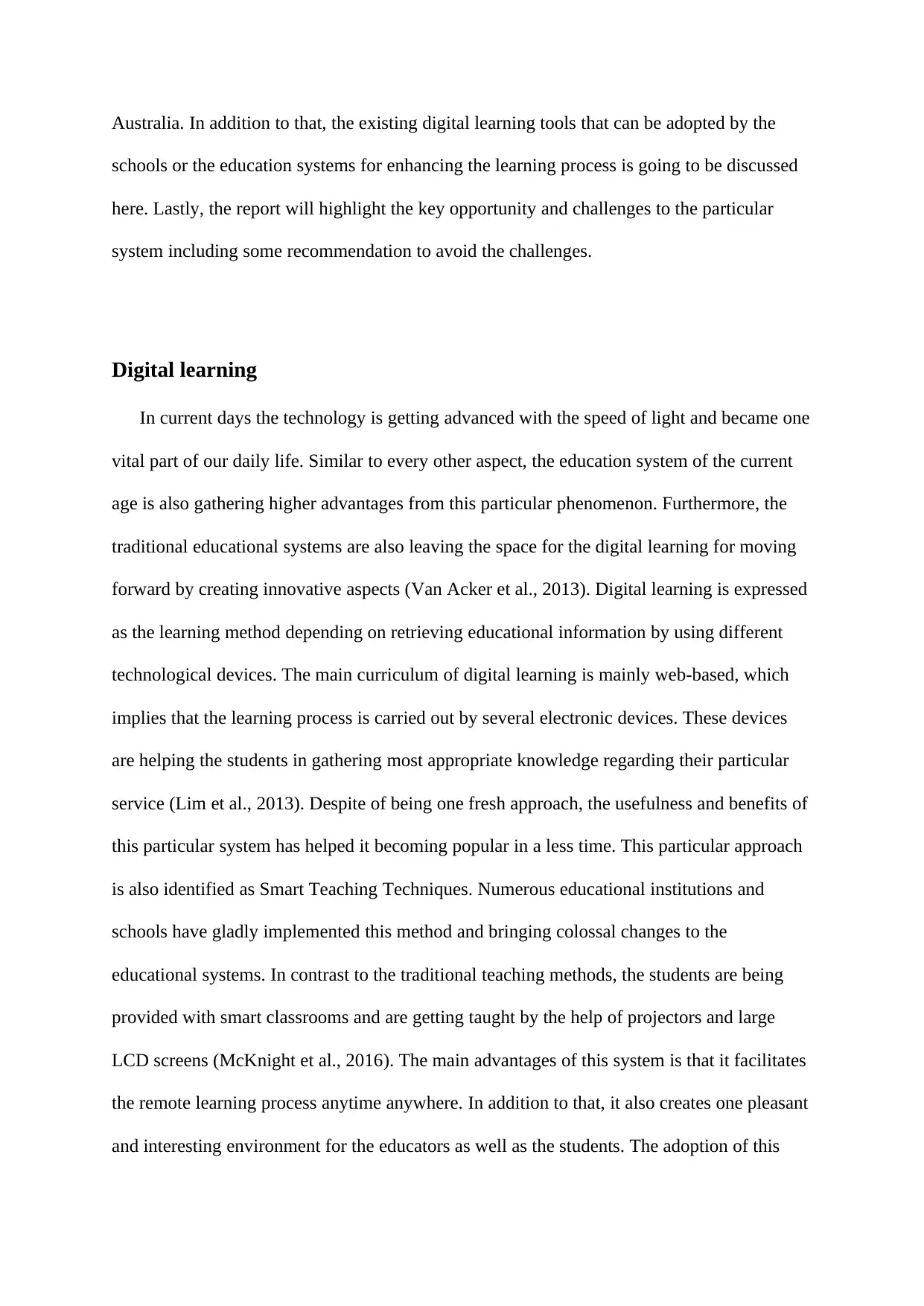
Australia. In addition to that, the existing digital learning tools that can be adopted by the
schools or the education systems for enhancing the learning process is going to be discussed
here. Lastly, the report will highlight the key opportunity and challenges to the particular
system including some recommendation to avoid the challenges.
Digital learning
In current days the technology is getting advanced with the speed of light and became one
vital part of our daily life. Similar to every other aspect, the education system of the current
age is also gathering higher advantages from this particular phenomenon. Furthermore, the
traditional educational systems are also leaving the space for the digital learning for moving
forward by creating innovative aspects (Van Acker et al., 2013). Digital learning is expressed
as the learning method depending on retrieving educational information by using different
technological devices. The main curriculum of digital learning is mainly web-based, which
implies that the learning process is carried out by several electronic devices. These devices
are helping the students in gathering most appropriate knowledge regarding their particular
service (Lim et al., 2013). Despite of being one fresh approach, the usefulness and benefits of
this particular system has helped it becoming popular in a less time. This particular approach
is also identified as Smart Teaching Techniques. Numerous educational institutions and
schools have gladly implemented this method and bringing colossal changes to the
educational systems. In contrast to the traditional teaching methods, the students are being
provided with smart classrooms and are getting taught by the help of projectors and large
LCD screens (McKnight et al., 2016). The main advantages of this system is that it facilitates
the remote learning process anytime anywhere. In addition to that, it also creates one pleasant
and interesting environment for the educators as well as the students. The adoption of this
schools or the education systems for enhancing the learning process is going to be discussed
here. Lastly, the report will highlight the key opportunity and challenges to the particular
system including some recommendation to avoid the challenges.
Digital learning
In current days the technology is getting advanced with the speed of light and became one
vital part of our daily life. Similar to every other aspect, the education system of the current
age is also gathering higher advantages from this particular phenomenon. Furthermore, the
traditional educational systems are also leaving the space for the digital learning for moving
forward by creating innovative aspects (Van Acker et al., 2013). Digital learning is expressed
as the learning method depending on retrieving educational information by using different
technological devices. The main curriculum of digital learning is mainly web-based, which
implies that the learning process is carried out by several electronic devices. These devices
are helping the students in gathering most appropriate knowledge regarding their particular
service (Lim et al., 2013). Despite of being one fresh approach, the usefulness and benefits of
this particular system has helped it becoming popular in a less time. This particular approach
is also identified as Smart Teaching Techniques. Numerous educational institutions and
schools have gladly implemented this method and bringing colossal changes to the
educational systems. In contrast to the traditional teaching methods, the students are being
provided with smart classrooms and are getting taught by the help of projectors and large
LCD screens (McKnight et al., 2016). The main advantages of this system is that it facilitates
the remote learning process anytime anywhere. In addition to that, it also creates one pleasant
and interesting environment for the educators as well as the students. The adoption of this
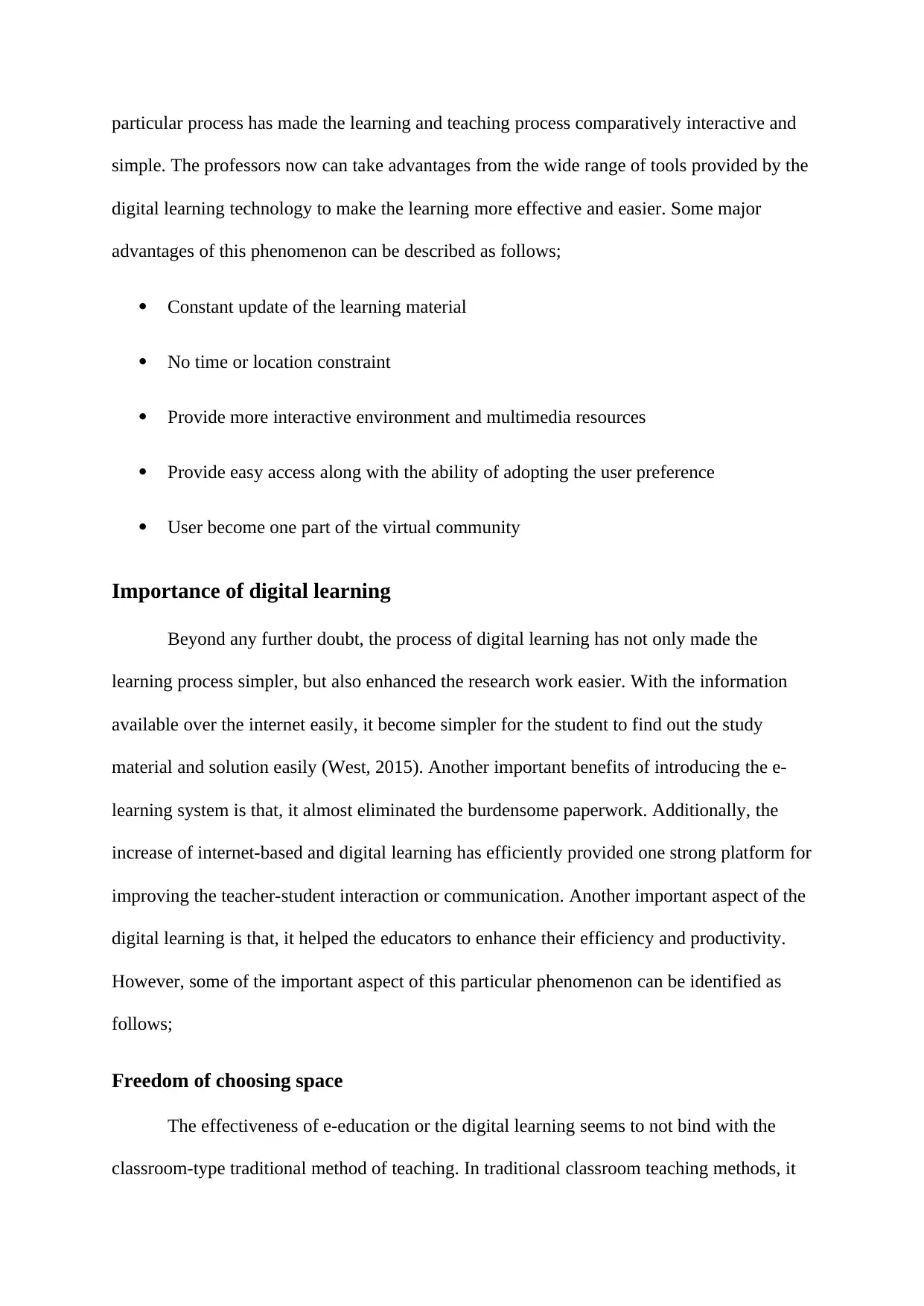
particular process has made the learning and teaching process comparatively interactive and
simple. The professors now can take advantages from the wide range of tools provided by the
digital learning technology to make the learning more effective and easier. Some major
advantages of this phenomenon can be described as follows;
Constant update of the learning material
No time or location constraint
Provide more interactive environment and multimedia resources
Provide easy access along with the ability of adopting the user preference
User become one part of the virtual community
Importance of digital learning
Beyond any further doubt, the process of digital learning has not only made the
learning process simpler, but also enhanced the research work easier. With the information
available over the internet easily, it become simpler for the student to find out the study
material and solution easily (West, 2015). Another important benefits of introducing the e-
learning system is that, it almost eliminated the burdensome paperwork. Additionally, the
increase of internet-based and digital learning has efficiently provided one strong platform for
improving the teacher-student interaction or communication. Another important aspect of the
digital learning is that, it helped the educators to enhance their efficiency and productivity.
However, some of the important aspect of this particular phenomenon can be identified as
follows;
Freedom of choosing space
The effectiveness of e-education or the digital learning seems to not bind with the
classroom-type traditional method of teaching. In traditional classroom teaching methods, it
simple. The professors now can take advantages from the wide range of tools provided by the
digital learning technology to make the learning more effective and easier. Some major
advantages of this phenomenon can be described as follows;
Constant update of the learning material
No time or location constraint
Provide more interactive environment and multimedia resources
Provide easy access along with the ability of adopting the user preference
User become one part of the virtual community
Importance of digital learning
Beyond any further doubt, the process of digital learning has not only made the
learning process simpler, but also enhanced the research work easier. With the information
available over the internet easily, it become simpler for the student to find out the study
material and solution easily (West, 2015). Another important benefits of introducing the e-
learning system is that, it almost eliminated the burdensome paperwork. Additionally, the
increase of internet-based and digital learning has efficiently provided one strong platform for
improving the teacher-student interaction or communication. Another important aspect of the
digital learning is that, it helped the educators to enhance their efficiency and productivity.
However, some of the important aspect of this particular phenomenon can be identified as
follows;
Freedom of choosing space
The effectiveness of e-education or the digital learning seems to not bind with the
classroom-type traditional method of teaching. In traditional classroom teaching methods, it
⊘ This is a preview!⊘
Do you want full access?
Subscribe today to unlock all pages.

Trusted by 1+ million students worldwide
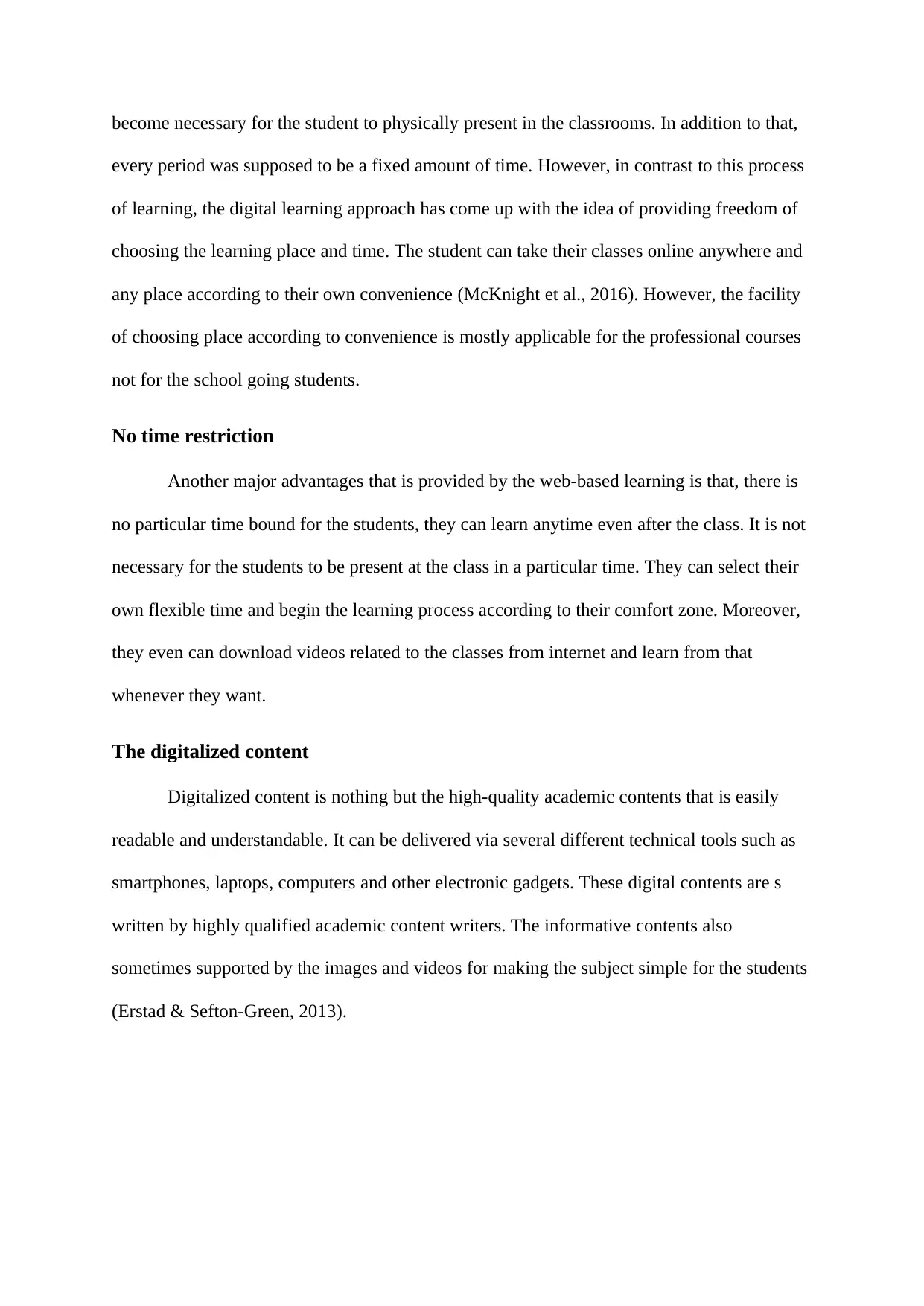
become necessary for the student to physically present in the classrooms. In addition to that,
every period was supposed to be a fixed amount of time. However, in contrast to this process
of learning, the digital learning approach has come up with the idea of providing freedom of
choosing the learning place and time. The student can take their classes online anywhere and
any place according to their own convenience (McKnight et al., 2016). However, the facility
of choosing place according to convenience is mostly applicable for the professional courses
not for the school going students.
No time restriction
Another major advantages that is provided by the web-based learning is that, there is
no particular time bound for the students, they can learn anytime even after the class. It is not
necessary for the students to be present at the class in a particular time. They can select their
own flexible time and begin the learning process according to their comfort zone. Moreover,
they even can download videos related to the classes from internet and learn from that
whenever they want.
The digitalized content
Digitalized content is nothing but the high-quality academic contents that is easily
readable and understandable. It can be delivered via several different technical tools such as
smartphones, laptops, computers and other electronic gadgets. These digital contents are s
written by highly qualified academic content writers. The informative contents also
sometimes supported by the images and videos for making the subject simple for the students
(Erstad & Sefton-Green, 2013).
every period was supposed to be a fixed amount of time. However, in contrast to this process
of learning, the digital learning approach has come up with the idea of providing freedom of
choosing the learning place and time. The student can take their classes online anywhere and
any place according to their own convenience (McKnight et al., 2016). However, the facility
of choosing place according to convenience is mostly applicable for the professional courses
not for the school going students.
No time restriction
Another major advantages that is provided by the web-based learning is that, there is
no particular time bound for the students, they can learn anytime even after the class. It is not
necessary for the students to be present at the class in a particular time. They can select their
own flexible time and begin the learning process according to their comfort zone. Moreover,
they even can download videos related to the classes from internet and learn from that
whenever they want.
The digitalized content
Digitalized content is nothing but the high-quality academic contents that is easily
readable and understandable. It can be delivered via several different technical tools such as
smartphones, laptops, computers and other electronic gadgets. These digital contents are s
written by highly qualified academic content writers. The informative contents also
sometimes supported by the images and videos for making the subject simple for the students
(Erstad & Sefton-Green, 2013).
Paraphrase This Document
Need a fresh take? Get an instant paraphrase of this document with our AI Paraphraser
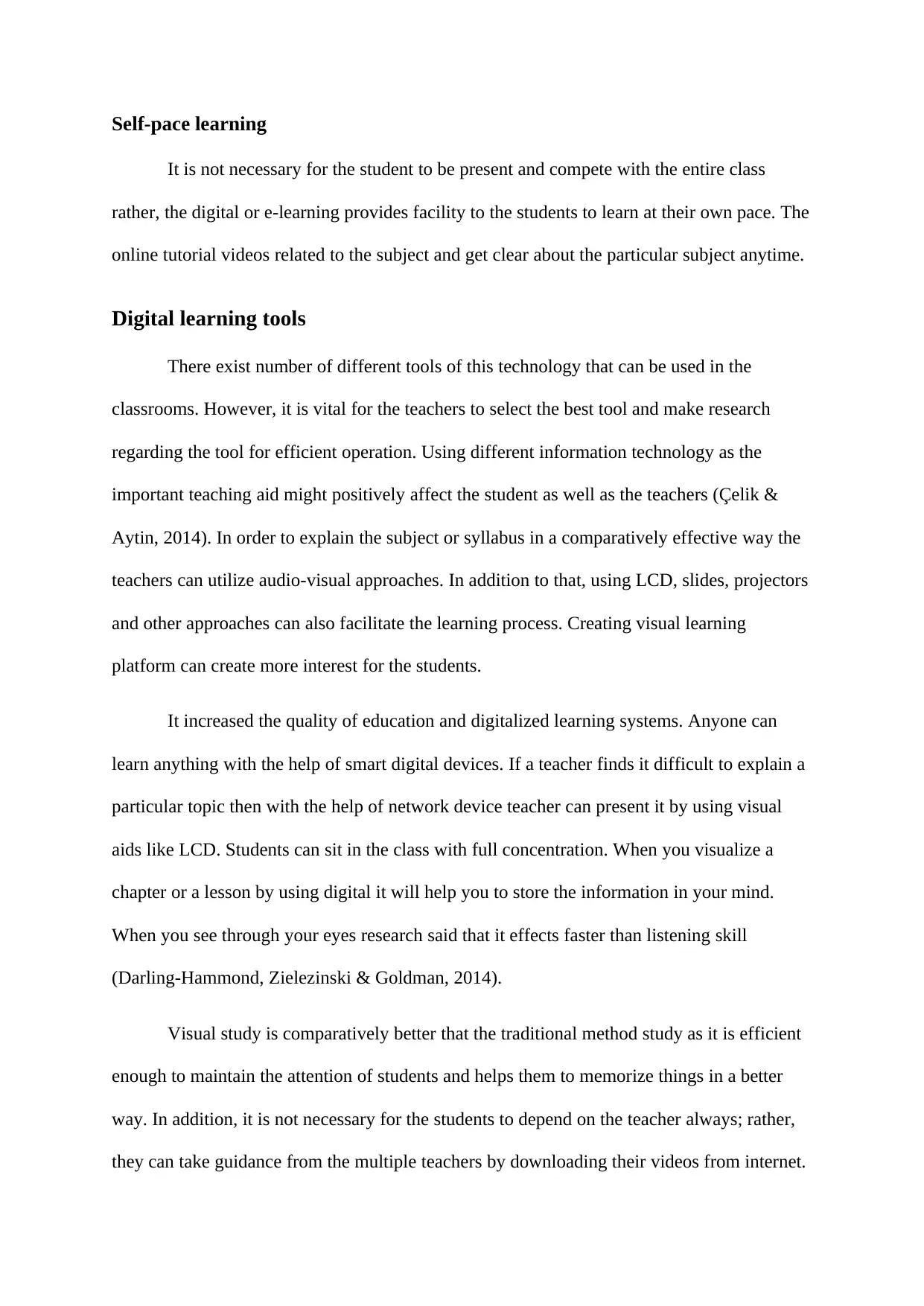
Self-pace learning
It is not necessary for the student to be present and compete with the entire class
rather, the digital or e-learning provides facility to the students to learn at their own pace. The
online tutorial videos related to the subject and get clear about the particular subject anytime.
Digital learning tools
There exist number of different tools of this technology that can be used in the
classrooms. However, it is vital for the teachers to select the best tool and make research
regarding the tool for efficient operation. Using different information technology as the
important teaching aid might positively affect the student as well as the teachers (Çelik &
Aytin, 2014). In order to explain the subject or syllabus in a comparatively effective way the
teachers can utilize audio-visual approaches. In addition to that, using LCD, slides, projectors
and other approaches can also facilitate the learning process. Creating visual learning
platform can create more interest for the students.
It increased the quality of education and digitalized learning systems. Anyone can
learn anything with the help of smart digital devices. If a teacher finds it difficult to explain a
particular topic then with the help of network device teacher can present it by using visual
aids like LCD. Students can sit in the class with full concentration. When you visualize a
chapter or a lesson by using digital it will help you to store the information in your mind.
When you see through your eyes research said that it effects faster than listening skill
(Darling-Hammond, Zielezinski & Goldman, 2014).
Visual study is comparatively better that the traditional method study as it is efficient
enough to maintain the attention of students and helps them to memorize things in a better
way. In addition, it is not necessary for the students to depend on the teacher always; rather,
they can take guidance from the multiple teachers by downloading their videos from internet.
It is not necessary for the student to be present and compete with the entire class
rather, the digital or e-learning provides facility to the students to learn at their own pace. The
online tutorial videos related to the subject and get clear about the particular subject anytime.
Digital learning tools
There exist number of different tools of this technology that can be used in the
classrooms. However, it is vital for the teachers to select the best tool and make research
regarding the tool for efficient operation. Using different information technology as the
important teaching aid might positively affect the student as well as the teachers (Çelik &
Aytin, 2014). In order to explain the subject or syllabus in a comparatively effective way the
teachers can utilize audio-visual approaches. In addition to that, using LCD, slides, projectors
and other approaches can also facilitate the learning process. Creating visual learning
platform can create more interest for the students.
It increased the quality of education and digitalized learning systems. Anyone can
learn anything with the help of smart digital devices. If a teacher finds it difficult to explain a
particular topic then with the help of network device teacher can present it by using visual
aids like LCD. Students can sit in the class with full concentration. When you visualize a
chapter or a lesson by using digital it will help you to store the information in your mind.
When you see through your eyes research said that it effects faster than listening skill
(Darling-Hammond, Zielezinski & Goldman, 2014).
Visual study is comparatively better that the traditional method study as it is efficient
enough to maintain the attention of students and helps them to memorize things in a better
way. In addition, it is not necessary for the students to depend on the teacher always; rather,
they can take guidance from the multiple teachers by downloading their videos from internet.
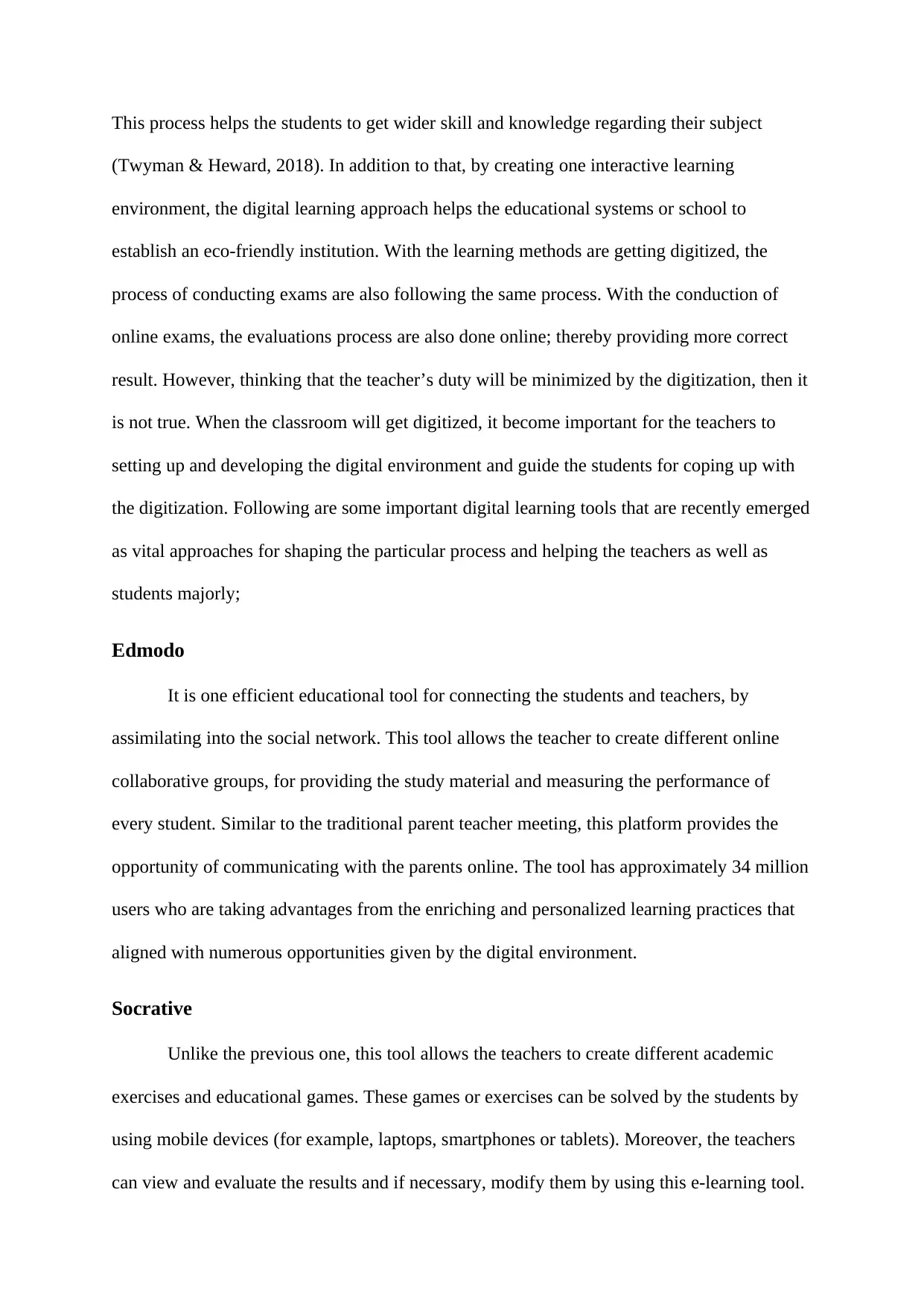
This process helps the students to get wider skill and knowledge regarding their subject
(Twyman & Heward, 2018). In addition to that, by creating one interactive learning
environment, the digital learning approach helps the educational systems or school to
establish an eco-friendly institution. With the learning methods are getting digitized, the
process of conducting exams are also following the same process. With the conduction of
online exams, the evaluations process are also done online; thereby providing more correct
result. However, thinking that the teacher’s duty will be minimized by the digitization, then it
is not true. When the classroom will get digitized, it become important for the teachers to
setting up and developing the digital environment and guide the students for coping up with
the digitization. Following are some important digital learning tools that are recently emerged
as vital approaches for shaping the particular process and helping the teachers as well as
students majorly;
Edmodo
It is one efficient educational tool for connecting the students and teachers, by
assimilating into the social network. This tool allows the teacher to create different online
collaborative groups, for providing the study material and measuring the performance of
every student. Similar to the traditional parent teacher meeting, this platform provides the
opportunity of communicating with the parents online. The tool has approximately 34 million
users who are taking advantages from the enriching and personalized learning practices that
aligned with numerous opportunities given by the digital environment.
Socrative
Unlike the previous one, this tool allows the teachers to create different academic
exercises and educational games. These games or exercises can be solved by the students by
using mobile devices (for example, laptops, smartphones or tablets). Moreover, the teachers
can view and evaluate the results and if necessary, modify them by using this e-learning tool.
(Twyman & Heward, 2018). In addition to that, by creating one interactive learning
environment, the digital learning approach helps the educational systems or school to
establish an eco-friendly institution. With the learning methods are getting digitized, the
process of conducting exams are also following the same process. With the conduction of
online exams, the evaluations process are also done online; thereby providing more correct
result. However, thinking that the teacher’s duty will be minimized by the digitization, then it
is not true. When the classroom will get digitized, it become important for the teachers to
setting up and developing the digital environment and guide the students for coping up with
the digitization. Following are some important digital learning tools that are recently emerged
as vital approaches for shaping the particular process and helping the teachers as well as
students majorly;
Edmodo
It is one efficient educational tool for connecting the students and teachers, by
assimilating into the social network. This tool allows the teacher to create different online
collaborative groups, for providing the study material and measuring the performance of
every student. Similar to the traditional parent teacher meeting, this platform provides the
opportunity of communicating with the parents online. The tool has approximately 34 million
users who are taking advantages from the enriching and personalized learning practices that
aligned with numerous opportunities given by the digital environment.
Socrative
Unlike the previous one, this tool allows the teachers to create different academic
exercises and educational games. These games or exercises can be solved by the students by
using mobile devices (for example, laptops, smartphones or tablets). Moreover, the teachers
can view and evaluate the results and if necessary, modify them by using this e-learning tool.
⊘ This is a preview!⊘
Do you want full access?
Subscribe today to unlock all pages.

Trusted by 1+ million students worldwide
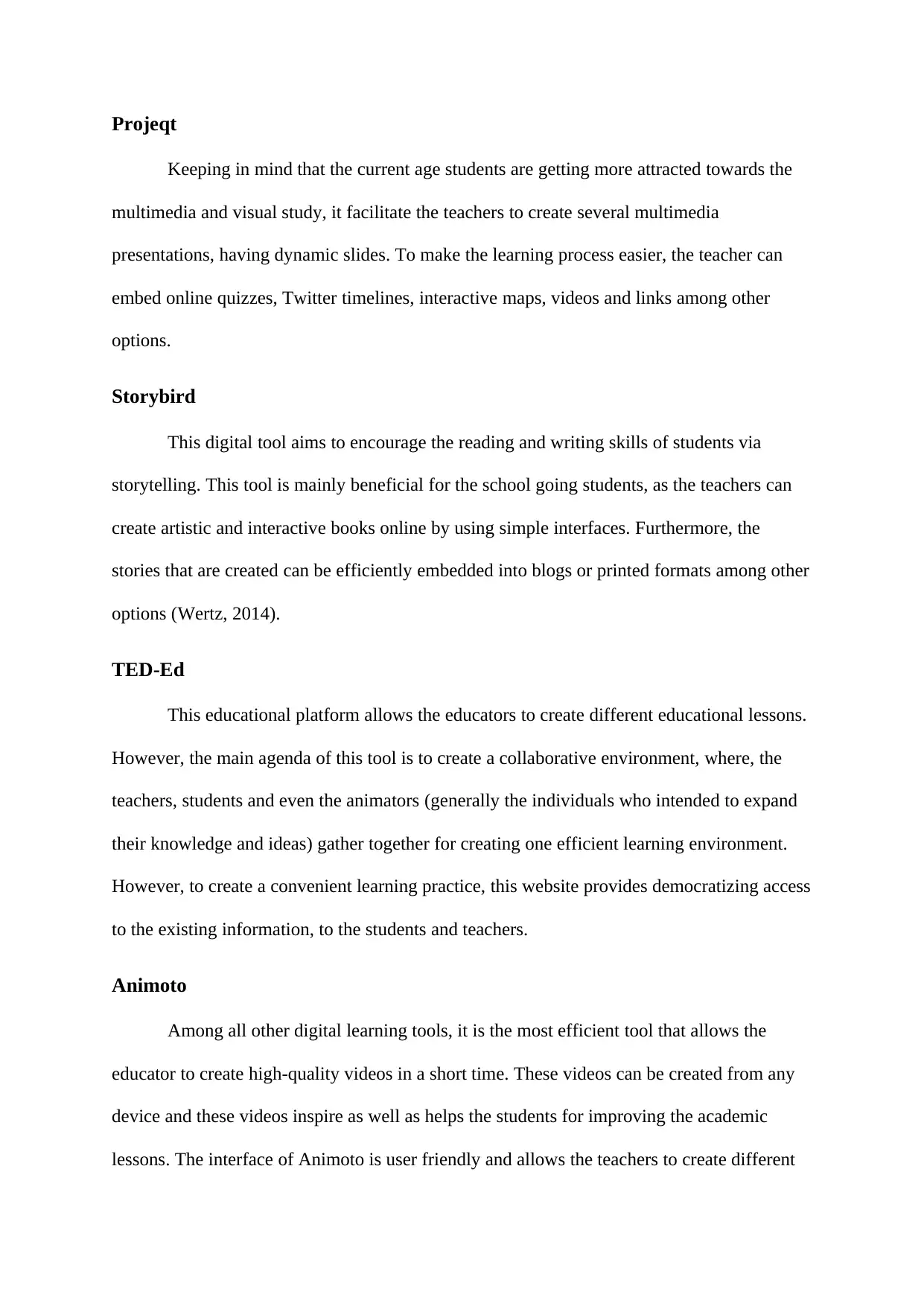
Projeqt
Keeping in mind that the current age students are getting more attracted towards the
multimedia and visual study, it facilitate the teachers to create several multimedia
presentations, having dynamic slides. To make the learning process easier, the teacher can
embed online quizzes, Twitter timelines, interactive maps, videos and links among other
options.
Storybird
This digital tool aims to encourage the reading and writing skills of students via
storytelling. This tool is mainly beneficial for the school going students, as the teachers can
create artistic and interactive books online by using simple interfaces. Furthermore, the
stories that are created can be efficiently embedded into blogs or printed formats among other
options (Wertz, 2014).
TED-Ed
This educational platform allows the educators to create different educational lessons.
However, the main agenda of this tool is to create a collaborative environment, where, the
teachers, students and even the animators (generally the individuals who intended to expand
their knowledge and ideas) gather together for creating one efficient learning environment.
However, to create a convenient learning practice, this website provides democratizing access
to the existing information, to the students and teachers.
Animoto
Among all other digital learning tools, it is the most efficient tool that allows the
educator to create high-quality videos in a short time. These videos can be created from any
device and these videos inspire as well as helps the students for improving the academic
lessons. The interface of Animoto is user friendly and allows the teachers to create different
Keeping in mind that the current age students are getting more attracted towards the
multimedia and visual study, it facilitate the teachers to create several multimedia
presentations, having dynamic slides. To make the learning process easier, the teacher can
embed online quizzes, Twitter timelines, interactive maps, videos and links among other
options.
Storybird
This digital tool aims to encourage the reading and writing skills of students via
storytelling. This tool is mainly beneficial for the school going students, as the teachers can
create artistic and interactive books online by using simple interfaces. Furthermore, the
stories that are created can be efficiently embedded into blogs or printed formats among other
options (Wertz, 2014).
TED-Ed
This educational platform allows the educators to create different educational lessons.
However, the main agenda of this tool is to create a collaborative environment, where, the
teachers, students and even the animators (generally the individuals who intended to expand
their knowledge and ideas) gather together for creating one efficient learning environment.
However, to create a convenient learning practice, this website provides democratizing access
to the existing information, to the students and teachers.
Animoto
Among all other digital learning tools, it is the most efficient tool that allows the
educator to create high-quality videos in a short time. These videos can be created from any
device and these videos inspire as well as helps the students for improving the academic
lessons. The interface of Animoto is user friendly and allows the teachers to create different
Paraphrase This Document
Need a fresh take? Get an instant paraphrase of this document with our AI Paraphraser
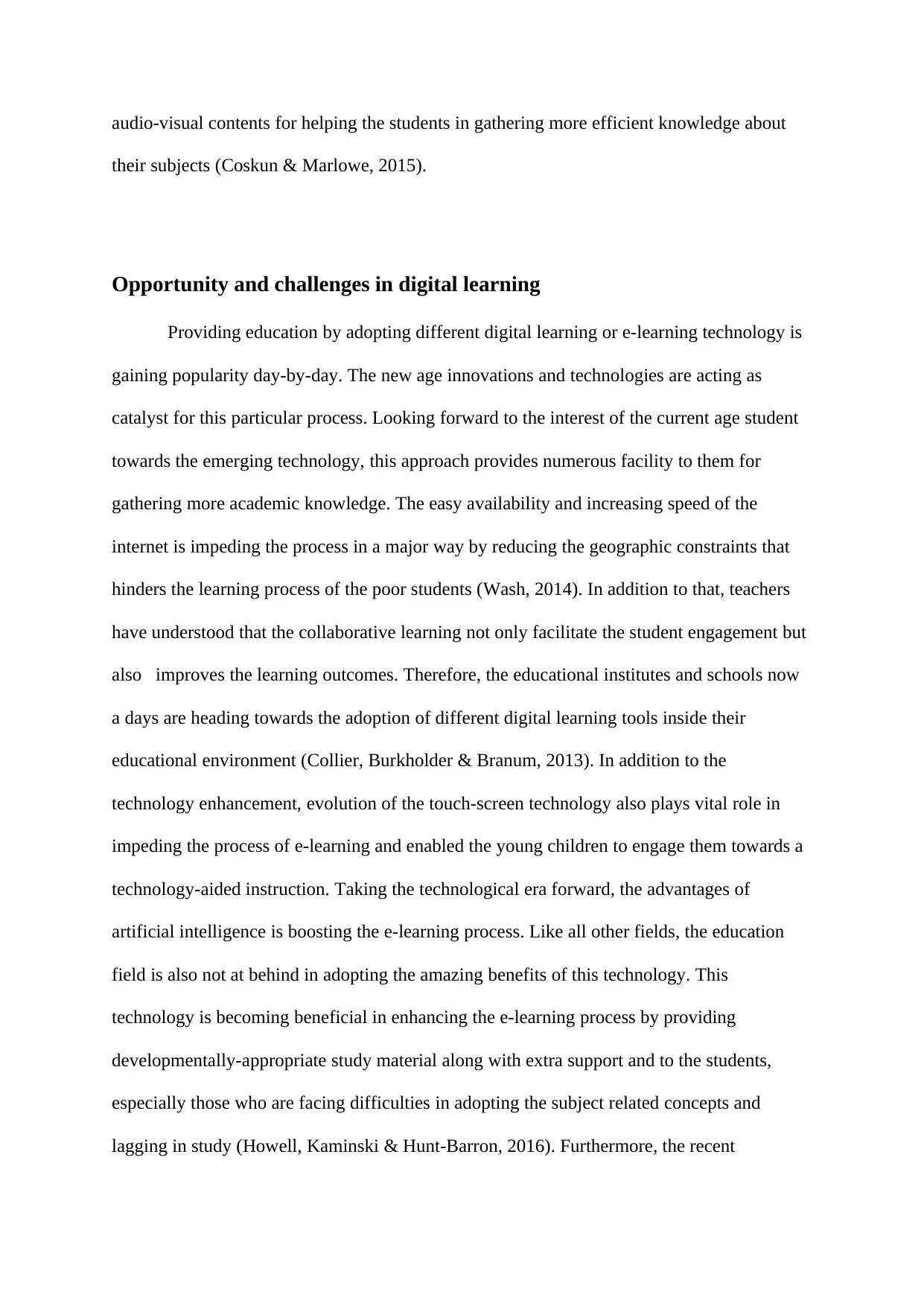
audio-visual contents for helping the students in gathering more efficient knowledge about
their subjects (Coskun & Marlowe, 2015).
Opportunity and challenges in digital learning
Providing education by adopting different digital learning or e-learning technology is
gaining popularity day-by-day. The new age innovations and technologies are acting as
catalyst for this particular process. Looking forward to the interest of the current age student
towards the emerging technology, this approach provides numerous facility to them for
gathering more academic knowledge. The easy availability and increasing speed of the
internet is impeding the process in a major way by reducing the geographic constraints that
hinders the learning process of the poor students (Wash, 2014). In addition to that, teachers
have understood that the collaborative learning not only facilitate the student engagement but
also improves the learning outcomes. Therefore, the educational institutes and schools now
a days are heading towards the adoption of different digital learning tools inside their
educational environment (Collier, Burkholder & Branum, 2013). In addition to the
technology enhancement, evolution of the touch-screen technology also plays vital role in
impeding the process of e-learning and enabled the young children to engage them towards a
technology-aided instruction. Taking the technological era forward, the advantages of
artificial intelligence is boosting the e-learning process. Like all other fields, the education
field is also not at behind in adopting the amazing benefits of this technology. This
technology is becoming beneficial in enhancing the e-learning process by providing
developmentally-appropriate study material along with extra support and to the students,
especially those who are facing difficulties in adopting the subject related concepts and
lagging in study (Howell, Kaminski & Hunt-Barron, 2016). Furthermore, the recent
their subjects (Coskun & Marlowe, 2015).
Opportunity and challenges in digital learning
Providing education by adopting different digital learning or e-learning technology is
gaining popularity day-by-day. The new age innovations and technologies are acting as
catalyst for this particular process. Looking forward to the interest of the current age student
towards the emerging technology, this approach provides numerous facility to them for
gathering more academic knowledge. The easy availability and increasing speed of the
internet is impeding the process in a major way by reducing the geographic constraints that
hinders the learning process of the poor students (Wash, 2014). In addition to that, teachers
have understood that the collaborative learning not only facilitate the student engagement but
also improves the learning outcomes. Therefore, the educational institutes and schools now
a days are heading towards the adoption of different digital learning tools inside their
educational environment (Collier, Burkholder & Branum, 2013). In addition to the
technology enhancement, evolution of the touch-screen technology also plays vital role in
impeding the process of e-learning and enabled the young children to engage them towards a
technology-aided instruction. Taking the technological era forward, the advantages of
artificial intelligence is boosting the e-learning process. Like all other fields, the education
field is also not at behind in adopting the amazing benefits of this technology. This
technology is becoming beneficial in enhancing the e-learning process by providing
developmentally-appropriate study material along with extra support and to the students,
especially those who are facing difficulties in adopting the subject related concepts and
lagging in study (Howell, Kaminski & Hunt-Barron, 2016). Furthermore, the recent
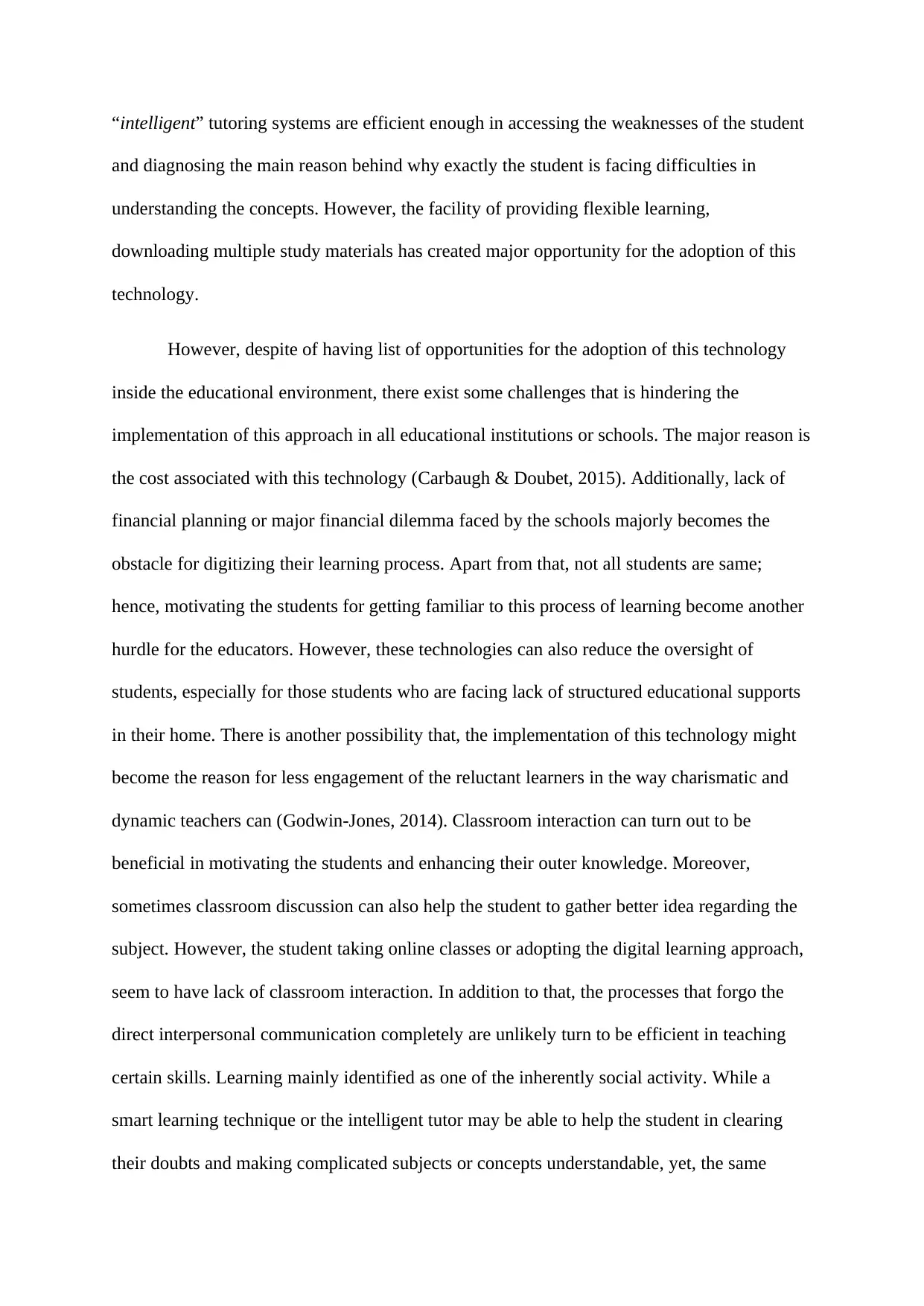
“intelligent” tutoring systems are efficient enough in accessing the weaknesses of the student
and diagnosing the main reason behind why exactly the student is facing difficulties in
understanding the concepts. However, the facility of providing flexible learning,
downloading multiple study materials has created major opportunity for the adoption of this
technology.
However, despite of having list of opportunities for the adoption of this technology
inside the educational environment, there exist some challenges that is hindering the
implementation of this approach in all educational institutions or schools. The major reason is
the cost associated with this technology (Carbaugh & Doubet, 2015). Additionally, lack of
financial planning or major financial dilemma faced by the schools majorly becomes the
obstacle for digitizing their learning process. Apart from that, not all students are same;
hence, motivating the students for getting familiar to this process of learning become another
hurdle for the educators. However, these technologies can also reduce the oversight of
students, especially for those students who are facing lack of structured educational supports
in their home. There is another possibility that, the implementation of this technology might
become the reason for less engagement of the reluctant learners in the way charismatic and
dynamic teachers can (Godwin-Jones, 2014). Classroom interaction can turn out to be
beneficial in motivating the students and enhancing their outer knowledge. Moreover,
sometimes classroom discussion can also help the student to gather better idea regarding the
subject. However, the student taking online classes or adopting the digital learning approach,
seem to have lack of classroom interaction. In addition to that, the processes that forgo the
direct interpersonal communication completely are unlikely turn to be efficient in teaching
certain skills. Learning mainly identified as one of the inherently social activity. While a
smart learning technique or the intelligent tutor may be able to help the student in clearing
their doubts and making complicated subjects or concepts understandable, yet, the same
and diagnosing the main reason behind why exactly the student is facing difficulties in
understanding the concepts. However, the facility of providing flexible learning,
downloading multiple study materials has created major opportunity for the adoption of this
technology.
However, despite of having list of opportunities for the adoption of this technology
inside the educational environment, there exist some challenges that is hindering the
implementation of this approach in all educational institutions or schools. The major reason is
the cost associated with this technology (Carbaugh & Doubet, 2015). Additionally, lack of
financial planning or major financial dilemma faced by the schools majorly becomes the
obstacle for digitizing their learning process. Apart from that, not all students are same;
hence, motivating the students for getting familiar to this process of learning become another
hurdle for the educators. However, these technologies can also reduce the oversight of
students, especially for those students who are facing lack of structured educational supports
in their home. There is another possibility that, the implementation of this technology might
become the reason for less engagement of the reluctant learners in the way charismatic and
dynamic teachers can (Godwin-Jones, 2014). Classroom interaction can turn out to be
beneficial in motivating the students and enhancing their outer knowledge. Moreover,
sometimes classroom discussion can also help the student to gather better idea regarding the
subject. However, the student taking online classes or adopting the digital learning approach,
seem to have lack of classroom interaction. In addition to that, the processes that forgo the
direct interpersonal communication completely are unlikely turn to be efficient in teaching
certain skills. Learning mainly identified as one of the inherently social activity. While a
smart learning technique or the intelligent tutor may be able to help the student in clearing
their doubts and making complicated subjects or concepts understandable, yet, the same
⊘ This is a preview!⊘
Do you want full access?
Subscribe today to unlock all pages.

Trusted by 1+ million students worldwide
1 out of 17
Related Documents
Your All-in-One AI-Powered Toolkit for Academic Success.
+13062052269
info@desklib.com
Available 24*7 on WhatsApp / Email
![[object Object]](/_next/static/media/star-bottom.7253800d.svg)
Unlock your academic potential
Copyright © 2020–2025 A2Z Services. All Rights Reserved. Developed and managed by ZUCOL.




